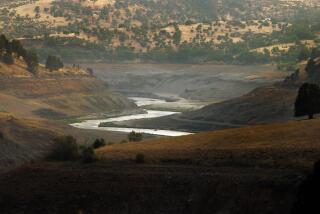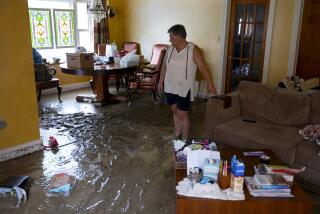125 years after Johnstown flood, U.S. dams need expensive fix
The last Friday in May dawned wet and stayed that way. Merchants in blue-collar Johnstown, Pa., hauled their wares to their buildings’ upper stories to wait out the expected flooding. Families moved furniture and stockpiled supplies.
But nothing prepared Johnstown for what happened that afternoon. The South Fork Dam broke, sending millions of tons of water hurtling down the Little Conemaugh River with more violence than Niagara Falls, picking up houses and trees and rocks and bodies as it decimated villages in southwestern Pennsylvania.
More than 2,200 men, women and children died that day, making the Johnstown flood of 1889 “the largest single-day civilian loss of life in American history until 9/11,” said Richard Burkert, president of the Johnstown Area Heritage Assn.
And the worst dam disaster on U.S. soil. And a cautionary tale that echoes to this day, 125 years later. As historians commemorate the carnage, civil engineers are warning that this country’s dams are in terrible shape, with a costly repair bill that could come due at any moment.
“We estimated that to upgrade all the dams that need upgrading, it would take $53.69 billion,” said Lori Spragens, executive director of the Assn. of State Dam Safety Officials. “For the high-hazard dams alone, it’s $18 billion. High-hazard dams are ranked by what’s downstream, if it fails and has the potential of killing one person … if one house is in the way.”
The biggest lesson learned from the Johnstown flood, Spragens said, is that safety officials need to “stay vigilant” and not shirk on upkeep.
“You cannot just let a dam sit there and age and try to take shortcuts with the fixes,” Spragens said. “It seems like they didn’t do anything right with [South Fork Dam], and they didn’t know what kind of destruction it could cause.”
Unfortunately, age and delayed maintenance are plaguing many of the country’s 84,000-plus dams. Spragens’ organization figures that between Jan. 1, 2005, and June 30, 2013, there were 173 dam failures and 587 incidents that “without intervention, would likely have resulted in dam failure.”
Although there is no top 10 list of bad dams, there is a top 10 of troubled states.
In its 2012 study, the Center for American Progress pegged the annual cost of the nation’s failing water infrastructure at $7.2 billion in damages and an average of 94 lives lost.
And the organization pointed to the following states -- in descending order of trouble -- as having the most “state-regulated, high-hazard dams in need of repair”: Georgia, Pennsylvania, Colorado, Ohio, North Carolina, Indiana, Mississippi, Massachusetts, New Mexico and New Jersey.
In the report, “Ensuring Public Safety by Investing in Our Nation’s Critical Dams and Levees,” the center noted that more than 28,000 dams -- about a third of the nation’s total -- are older than 50, which is the “standard intended lifespan” of most such structures.
About 14,000 dams are classified as “high-hazard,” the center said, and “in 2008 more than 2,000 of these high-hazard dams were also rated structurally ‘deficient,’ meaning they were at serious risk of failure.”
One does not need to look back 125 years to find death and destruction resulting from massive dam failure.
The 2003 failure of Michigan’s Silver Lake Dam caused more than $100 million in damages and put 1,100 iron mine workers temporarily out of their jobs. A year later, in Mississippi, the Big Bay Lake Dam failed, damaging or destroying around 100 homes, along with churches, businesses and a fire station.
And then there was the Kaloko Reservoir Dam in Hawaii, which killed seven people when it failed in 2006, releasing 300 million gallons of water that damaged a state highway and washed away homes and farms.
Kaloko was “a textbook example of what not to do,” Spragens said. “Hawaii had very, very low standards for enforcement and regulations. [The private owner] told them they couldn’t come on his property, and they left for years. They’ve turned the corner in Hawaii and come a long way.… But it was ridiculous. That’s a worst-case scenario.”
The American Society of Civil Engineers, in its 2013 report card on the country’s infrastructure, gave the nation’s dams a D grade.
“The nation’s dams are aging and the number of high-hazard dams is on the rise,” the organization said. “Many of these dams were built as low-hazard dams protecting undeveloped agricultural land. However, with an increasing population and greater development below dams, the overall number of high-hazard dams continues to increase, to nearly 14,000 in 2012.”
Although there are red-flag dams throughout the country, not all states are in the same terrible shape. The spectrum of dam safety would have California at the zenith, and Alabama at the nadir.
The Golden State has more dam inspectors than any other and the lowest ratio of dams to inspectors of any state in the country, according to the Assn. of State Dam Safety Officials. In contrast, the Heart of Dixie is the only state without a dam safety program.
“California has the Cadillac version of the dam safety program, and Alabama has nothing,” Spragens said. “Alabama is the only state in the nation without laws on the books to regulate dams.”
Which brings us back to the Johnstown flood and its 2,209 victims, who will be commemorated with a half-marathon along the 14-mile path of flood destruction, a walking tour of flood sites, and an interfaith prayer service among other events. Every victim’s name will be read aloud.
Although every dam -- and dam failure -- is different, Spragens said, a few things do not change, among them the need for care, money and vigilance.
“So many things can happen when a huge wall of water is released,” she said. “It’s totally uncontrollable.”
More to Read
Sign up for Essential California
The most important California stories and recommendations in your inbox every morning.
You may occasionally receive promotional content from the Los Angeles Times.











